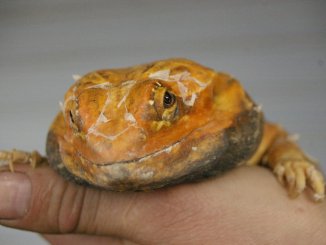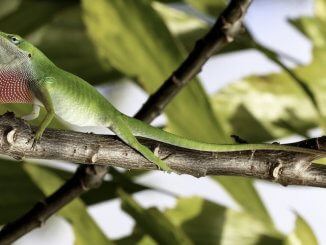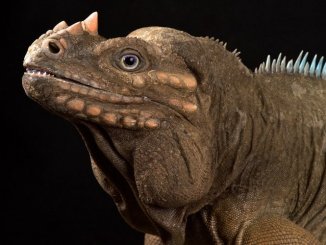The Red-Eyed Crocodile Skink is a unique and exotic reptile that is becoming increasingly popular.
These lizards are mostly found in New Guinea and Indonesia. They are loved for their red-eye rings and armor-like scales (similar to a crested Gecko)!
There are eight known species of Crocodile Skink, with the Tribolonotus gracilis (i.e. Red-Eyed) being the most-popular species in captivity.
This reptile was discovered as recently as the early 1990s, therefore little is known about them.
If you are ready to introduce a new and beautiful reptile to your home, or have just adopted this species and need to learn how to care for them, look no further than our guide below!
What Is A Red-Eyed Crocodile Skink?
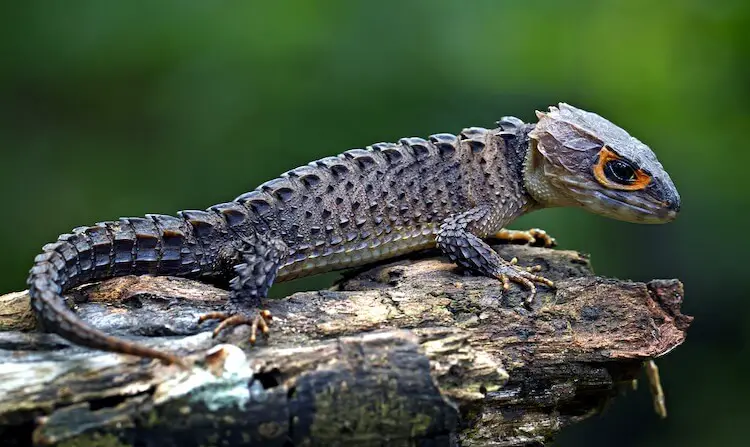
There are eight species of Crocodile Skinks which are found distributed amongst the rainforests of New Guinea, Indonesia, Maus, New Britain, Bougainville, and the Solomon islands.
Red-Eyed Crocodile Skinks like to spend most of their time on the moist ground, hiding under bushes or logs.
Adults are gray-black in color, with a solid red-orange ring around their eyes. They are a unique skink because they have the ability to vocalize! Most lizards, except for Geckos, are unable to do this.
Many owners love them because of their red-eyes and ability to vocalize.
These lizards are not overly difficult to care for. However, because they are fairly new to the pet-trade, it may take a more experienced owner to fully understand how to keep them happy and healthy. Their habitat should be kept hot and humid, and they need access to UVB light for 12 hours a day.
The Red-Eyed Crocodile Skink is relatively small. They are tiny when compared with some captive Geckos, because of this, they are happy to eat small insects (e.g. crickets or other invertebrates) every 48 hours.
They are not fond of being handled by people. When a Red-Eyed Crocodile Skink feels threatened, they have the ability to lose their tails and freeze. They will stay very still and fall over, giving the appearance of playing dead.
| Quick Facts | |
|---|---|
| Common Names | Spiny Skink |
| Scientific Name | Tiliqua scincoides |
| Adult Size | 1.5 to 10 inches, 36 to 45 grams |
| Lifespan | 5-12 years |
| Diet | Insects |
| Tank Size | 10-gallons (for two skinks) |
| Humidity & Temperature | 75-78°F with a 82°F basking spot. Humidity should be kept between 70-90% |
| Popular Alternatives | Blue-Tongued Skink |
Red-Eyed Crocodile Skink Care Guide
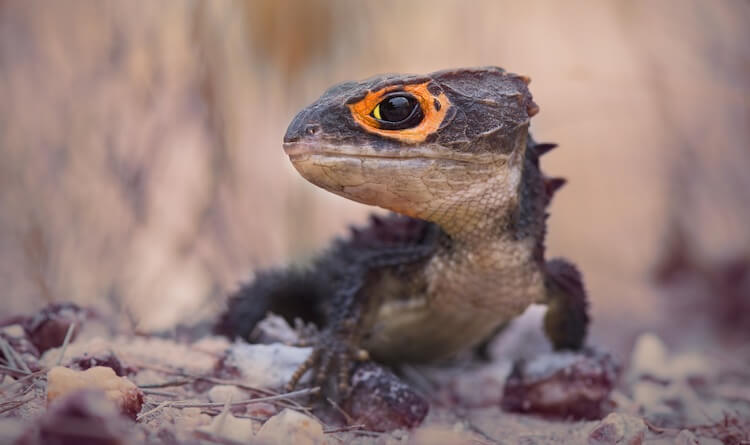
In the wild, Red-Eyed Crocodile Skinks spend their time on the rainforest floor, hiding under rocks or logs. The rainforests they live in are hot and humid. They love this environment!
When they found in the wild it’s common for them to be near a pool of water (this helps with the humidity).
Tank and Enclosure
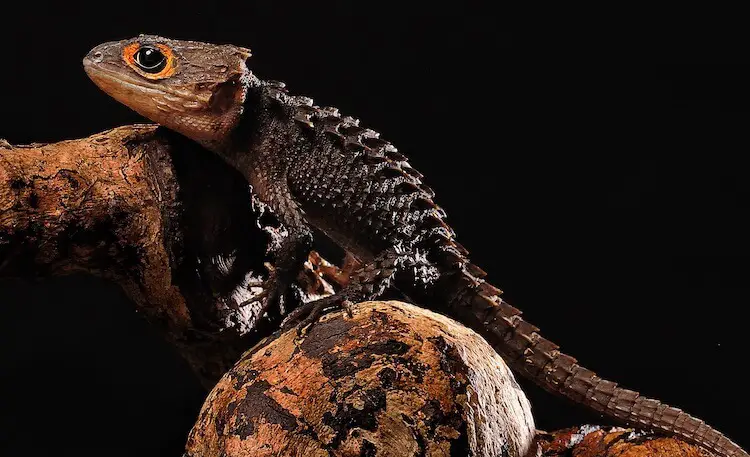
To replicate their natural environment, the cage should include several rocks and logs for your Red-Eyed Crocodile Skink to hide under. They enjoy spending lots of time in these cool, moist places.
A Red-Eyed Crocodile Skink does well in a glass enclosure that is a minimum of 10-gallons in size. A cage this size will be suitable for two skinks. If you are planning to keep three or four, your tank should be a minimum of 20-gallons.
Lighting and Heating
Lighting is very important for your Skink because UV B radiation encourages the production of vitamin D3 which isomerizes from pre-vitamin D3.
Whilst vitamin D3 can be given as a supplement in their diet, your skink should have access to 12 hours of UVB light per day. This can be achieved through natural lighting or by a UVB bulb:
- Natural lighting works provided you can guarantee routine and frequent exposure
- Most owners find it easier to use a UVB bulb to keep a consistent 12 hours of day light. A cage top that allows airflow is best as they allow for UVB transmission
As well as UVB lighting, a Red-Eyed Crocodile Skink should also have a heat lamp to create a basking spot. The basking area should be 80℉-82℉.
Some owners also find having an under-tank heater (to keep the enclosure at the desired temperature) works well to achieve the required 75℉-78℉ temperature.
Thermometers should be kept in both areas to ensure correct heat-cycles in the tank. The tank should be misted 2-3 times daily to keep humidity levels between 70% and 90%.
Substrate
These skinks are not fussy about their substrate in captivity.
Paper towels are a type of substrate that can be cleaned out easily. Because the environment must be kept moist and humid, bacteria are more likely to grow, and paper towels allow for a quicker and more efficient clean-up.
Rich soil is another type of substrate that will mimic the natural setting of a rainforest, however, this substrate may be more difficult to clean. It may also be more difficult to tell if there is an excess of bacterial growth in the soil.
| Tank Tips | |
|---|---|
| Tank Type | Glass / 10-gallon |
| Lighting | Basking light and 12 hours of UVB light |
| Best Substrate | Paper towels |
What To Feed A Crocodile Skink?
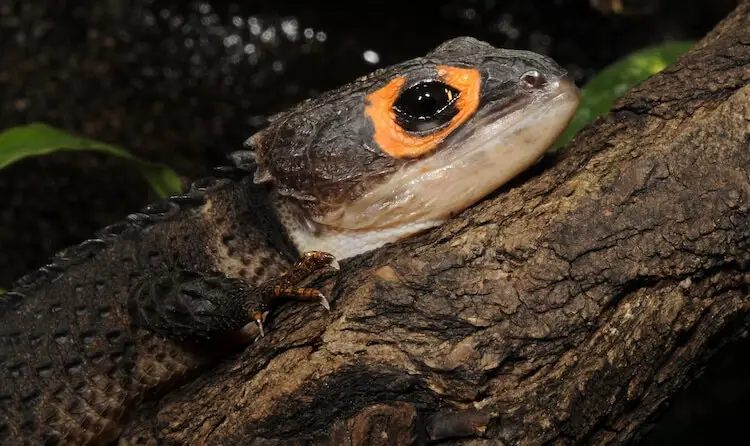
In their natural environment, Red-Eyed Crocodile Skinks will come out at dawn and dusk to eat twice a day. This is common in many lizards as morning and dusk is the time of day they are most active.
A suitable diet for this lizard is small-insects and other invertebrates, such as crickets, silkworms, and red worms. Their diet requires live-prey, which can be found at a local reptile or pet-supplies store:
- Adults should be fed about three crickets every 48 hours (sticking to the dusk-dawn feeding routine)
- Juveniles will eat two crickets every 24 hours instead
While caring for the Red-Eyed Crocodile Skink, owners should dust their food with calcium and Vitamin D3 to supplement their diet. If they do not eat all of their food, it should be removed as you spot-clean the tank.
Finally, as with any lizard, they should have access to clean water. A shallow bowl of water would suit them best to stop them from knocking it over.
| Diet Summary | |
|---|---|
| Insects | Three insects every two days (adults) |
| Fruits | 0% |
| Vegetables | 0% |
| Supplements Required | Calcium, Vitamin D3 |
How To Keep Them Healthy
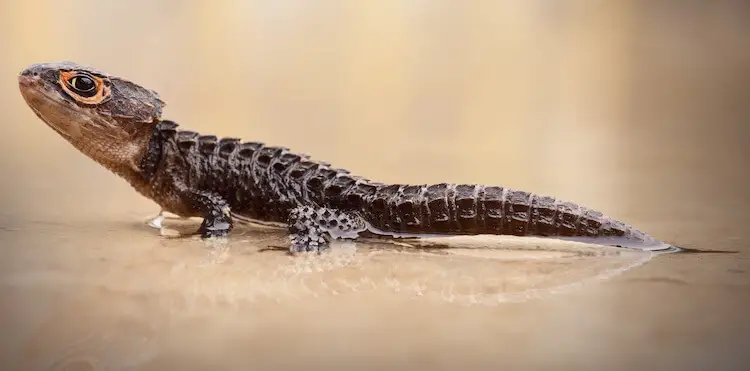
You should always wash your hands before and after handling your Red-Eyed Crocodile Skink. This will support correct hygiene for both you and your pet helping to keep you both healthy.
Red-Eyed Crocodile Skinks should be handled infrequently, as handling will increase their stress levels. If you do handle them, do so with a flat hand, and keep them near the ground in case they decide to jump.
A happy and healthy Skink will live for between 5-12 years.
As with any lizard, they can experience metabolic bone disorder from a calcium deficiency, which is why it’s so important to supplement their diet. This is characterized by a wobbly-walk.
They can also lose their tail if they feel threatened. This is known as tail autotomy, but their tail will grow back, but is susceptible to bacterial infections that can be avoided by cleaning the tank regularly and not stressing them to that point in the first place.
Red-Eyed Crocodile Skinks should have no trouble shedding, and bathing them will likely only increase their stress level because of handling.
Because high moisture levels, which are required for humidity levels between 70-90%, can easily lead to bacterial growth, the tank should be thoroughly cleaned and wiped down every week.
| Signs They Are Healthy | Sickness Symptoms |
|---|---|
| Happy to bask | Vocalizing distress |
| Eating at dawn or dusk | Freezing |
| Hiding under logs | Tail loss |
| Eyes are clean and alert | Wobbly when walking |
Red-Eyed Crocodile Skink Behavior
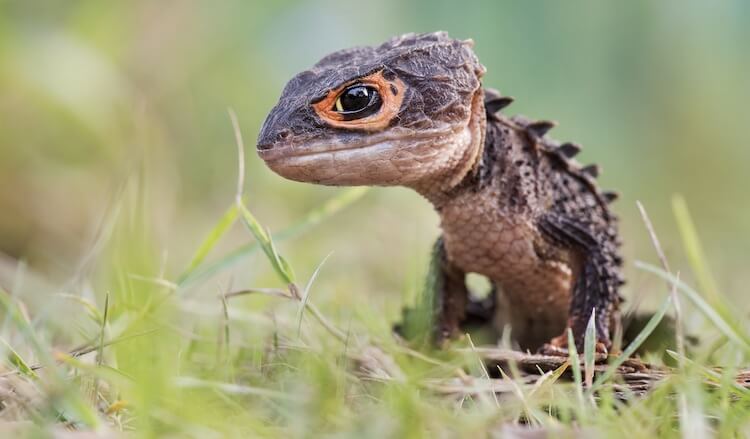
In the wild, Red-Eyed Crocodile Skinks will spend much of their time hiding under wet rocks or logs. They come out at dusk and dawn to feed on insects. This is a natural behavioral pattern for them with time spent basking too.
When they feel threatened, they will let out a chirp, squawk, or bark, an ability that usually only belongs to geckos. They are one of the only lizards, other than geckos, that have the ability to vocalize.
If vocalizing their distress doesn’t ward off a predator, they will vomit and lose their tails (i.e. autotomize)! They will then perform an action known as freezing where they appear to play-dead and fall over until the predator or threat is gone.
In terms of interacting with other Crocodile Skinks, they are more sociable than other species of reptiles. They coexist in peace, and can even live in small groups in tanks, given that no more than one male is living in a tank at a time.
Handling
Red-Eyed Crocodile Skinks are not aggressive. However, they should still be handled infrequently because handling generally frightens these skinks.
They are more of for-show reptile, rather than a companion or handling-reptile. Handling may cause them to freeze or to lose their tails.
If they must be handled, do so with a flat, open hand and allow them to crawl into it. Keep them close to the ground in case they decide to jump, and never close them inside your palm.
Appearance
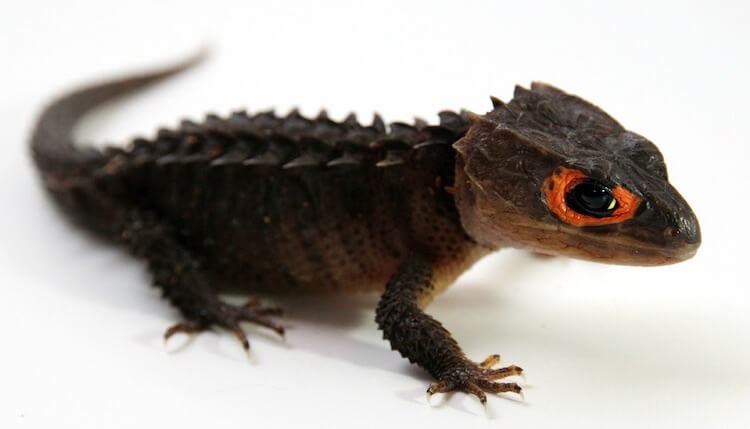
Identified by their unique spinose scales, the Red-Eyed Crocodile Skink’s scales are pointed and act as a protective armor.
Their pinose scales resemble tiny crocodiles, hence their name “Crocodile Skink”. However, they are not a real crocodile.
There are a few noticeable differences between males and females:
- Males are typically larger and stockier
- Males have large pores on the palmar surfaces of their hind feet
- Males have enlarged, orange-tinted scales near their umbilical scars
Both females and males also have an acoustic dimorphism in their voices, suggesting that their larynxes may be physically different (however this hasn’t been confirmed yet).
Size
The Red-Eyed Crocodile Skink will grow from 2.5 inches at birth to a max of 10 inches, weighing between 36 to 45 grams (depending on the species).
To grow from their birth size (of 2.5 inches), to fully mature adult lizards will take between 3-4 years.
Colors
Juvenile Red-Eyed Crocodile Skinks will have a lightly colored head and their heads will darken as they mature.
An adult will be gray, brown and black in color with a solid ring of red-orange scales around their eyes.
How To Sex A Crocodile Skink
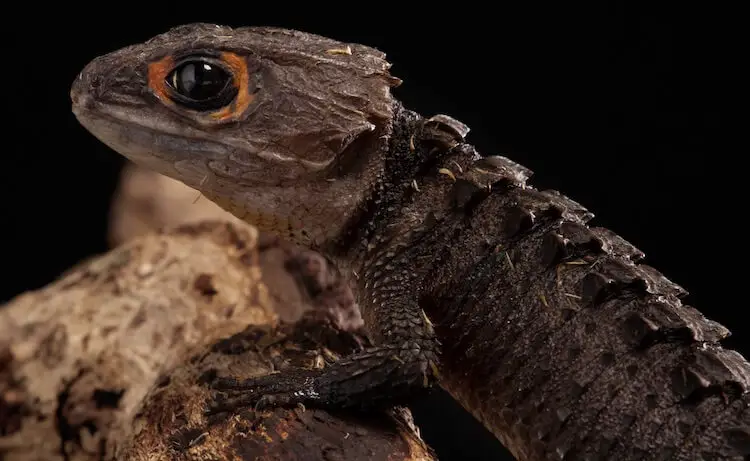
When a female Red-Eyed Crocodile Skink is bred, the incubation period is around 60 days and only one egg will be laid per clutch (unique to just this Skink).
Another feature that makes Crocodile Skinks unique is that females are highly protective of their young.
When an egg is incubating, she will curl herself around the egg protectively. She will also lunge at predators with her mouth open if they threaten the egg (this includes humans)!
After baby Red-Eyed Crocodile Skinks hatch, they tend to stick very close to their mother. If a person handled one of the babies, the mother will become very distressed. The father tends not to show any aggression if the hatchlings are disturbed, but will hang around the young reptiles every once in a while.
How Much Does A Red-Eyed Crocodile Skink Cost?
They may range from between $130 to $280 USD depending up which breeder or reptile retailer you purchase from.
Crocodile skinks are becoming increasingly popular in trade, but little is still known about them because they were recently discovered in the 1990s.
They have mixed levels of legal protection in their different countries of origin. New Guinea, for example, does not allow for their exportation, but other countries do.
Because of this, there is a high potential for these skinks to become a factor in the illegal pet-trade. A vast majority of Skinks imported to the United States are wild-caught as opposed to captive-bred.
Care Guide Summary
| Pros | Cons |
|---|---|
| Unique voice and colors (especially their red-orange eye scales) | Easily become stressed during handling |
| Simple feeding routine (three insects every 48 hours) | Not much is known about them in comparison to other pet-reptiles |
| Lighting is easy to manage (12 hours of UVB lighting and a basking light) |
Because the exact specifics and needs of Red-Eyed Crocodile Skink are still relatively unclear, they may thrive best under the care of someone who fully understands what a happy and healthy reptile looks like.
If you find yourself ready for a Red-Eyed Crocodile Skink, prepare yourself to be the owner of a unique lizard!
They have voices that are unique only to this kind of skink, and their bright red-eye rings truly pop against their black shiny scales.
Known for being easy to care for as they do not eat very much and only require a small cage and non-specialized heating and lighting.
Even though they don’t enjoy handling, they are also unique in that they tolerate living in groups, so you can even have more than one! Overall, they are unique lizards that can be an exotic pet for any home.

